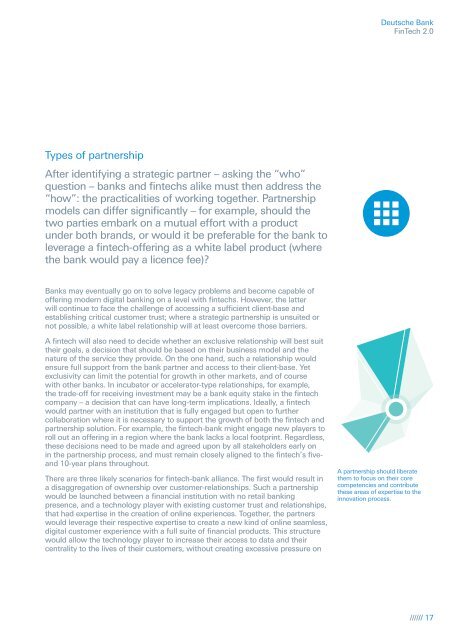FinTech 2.0
YKHHI
YKHHI
Create successful ePaper yourself
Turn your PDF publications into a flip-book with our unique Google optimized e-Paper software.
Deutsche Bank<br />
<strong>FinTech</strong> <strong>2.0</strong><br />
Types of partnership<br />
After identifying a strategic partner – asking the “who”<br />
question – banks and fintechs alike must then address the<br />
“how”: the practicalities of working together. Partnership<br />
models can differ significantly – for example, should the<br />
two parties embark on a mutual effort with a product<br />
under both brands, or would it be preferable for the bank to<br />
leverage a fintech-offering as a white label product (where<br />
the bank would pay a licence fee)?<br />
Banks may eventually go on to solve legacy problems and become capable of<br />
offering modern digital banking on a level with fintechs. However, the latter<br />
will continue to face the challenge of accessing a sufficient client-base and<br />
establishing critical customer trust; where a strategic partnership is unsuited or<br />
not possible, a white label relationship will at least overcome those barriers.<br />
A fintech will also need to decide whether an exclusive relationship will best suit<br />
their goals, a decision that should be based on their business model and the<br />
nature of the service they provide. On the one hand, such a relationship would<br />
ensure full support from the bank partner and access to their client-base. Yet<br />
exclusivity can limit the potential for growth in other markets, and of course<br />
with other banks. In incubator or accelerator-type relationships, for example,<br />
the trade-off for receiving investment may be a bank equity stake in the fintech<br />
company – a decision that can have long-term implications. Ideally, a fintech<br />
would partner with an institution that is fully engaged but open to further<br />
collaboration where it is necessary to support the growth of both the fintech and<br />
partnership solution. For example, the fintech-bank might engage new players to<br />
roll out an offering in a region where the bank lacks a local footprint. Regardless,<br />
these decisions need to be made and agreed upon by all stakeholders early on<br />
in the partnership process, and must remain closely aligned to the fintech’s fiveand<br />
10-year plans throughout.<br />
There are three likely scenarios for fintech-bank alliance. The first would result in<br />
a disaggregation of ownership over customer-relationships. Such a partnership<br />
would be launched between a financial institution with no retail banking<br />
presence, and a technology player with existing customer trust and relationships,<br />
that had expertise in the creation of online experiences. Together, the partners<br />
would leverage their respective expertise to create a new kind of online seamless,<br />
digital customer experience with a full suite of financial products. This structure<br />
would allow the technology player to increase their access to data and their<br />
centrality to the lives of their customers, without creating excessive pressure on<br />
A partnership should liberate<br />
them to focus on their core<br />
competencies and contribute<br />
these areas of expertise to the<br />
innovation process.<br />
////// 17


